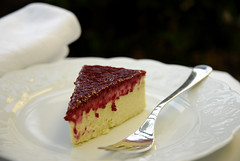
There are many variations on the basic recipe of bread, including pizza, focaccia, baguettes, brioche, challah, lavash, biscuits, pretzels, bagels, and others. Here we have the cheese bread, also called cheese bun and cheese puff, which is a small, cheese-flavored roll, that’s one of the most popular snacks in Brazil. There are pao de queijo stores everywhere, you also can find them in bakeries, snack bars, convenience stores, movie theaters, and frozen in supermarkets. They’re very cheesy and I always thought Americans would also love them. Nowadays you can find cheese breads in US at the Brazilian churrascarias (steakhouses), or frozen in some supermarkets, but they’re so easy to make at home that everybody should try! The only ingredient that can be harder to find is the tapioca flour (polvilho azedo in Portuguese). Another good thing about it is that Brazilian cheese bread is naturally wheat-free and gluten-free, making it great for individuals with wheat intolerance or celiac disease! Here’s the recipe:
1/2 kilo de polvilho azedo (tapioca flour)
3 cups of milk
1 cup of vegetable oil
1 tablespoon of salt
4 eggs
500g de Parmesan or other hard cheese, grated
Pre-heat the oven at high heat for 15 minutes. In a bowl mix the flour and salt. In a saucepan bring milk and oil to a boil. Pour the milk into the flour, stirring well until you have homogeneous dough. Let the dough cool. Add the eggs and mix the dough with your hands, until it becomes creamy but dry. Add the cheese and mix well. Place a little oil on the hands and round dough into balls. Arrange on a baking sheet. Bake at 375 degrees Fahrenheit until done, about 20 minutes. Serve immediately.









